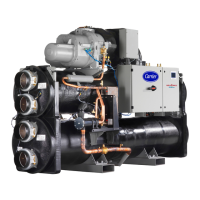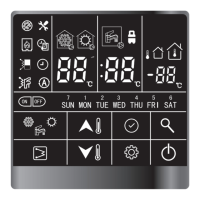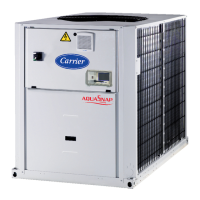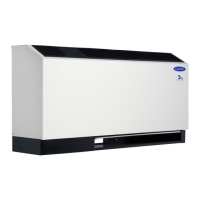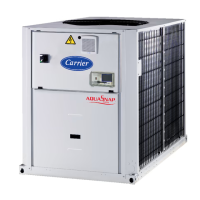1. Torque application to tighten the lug
2. Avoid contact between the two nuts
3. Lug tightening nut
4. Flat lug
5. Counter-nut
6. Terminal tightening nut
7. Isolator
11.5 - Tightening torques for the main bolts and
screws
Screw type Used for
Torque
value, N·m
M20 nut Chassis 190
M20 nut Heat exchanger side-side connection 240
M16 nut Compressor xing 190
H M16 screw
Heat exchanger water boxes,
structure
190
H M16 screw Compressor suction anges 190
H M20 screw Compressor suction anges TU & TV 240
M16 nut Compressor discharge line TU 190
M20 nut Compressor discharge line TV 240
H M8 screw Drier cover 35
1/8 NPT
connection
Oil line 12
TE nut Compressor oil line 24,5
7/8 ORFS nut Oil line 130
5/8 ORFS nut Oil line 65
3/8 ORFS nut Oil line 26
H M6 screw Stauff collar 10
Taptite screw M6 Oil line collar 7
Metric screw M6 Plate xing, control box, terminal box 7
Taptite screw M10 Oil lter, control box xing 30
ATTENTION: The tightening of the connections at the
compressor terminals requires special precautions. Please
refer to the chapter above.
11.6 - Evaporator and condenser maintenance
Check that:
• the insulating foam is intact and securely in place,
• the sensors and ow switch are correctly operating and
correctly positioned in their support,
• the water-side connections are clean and show no sign of
leakage.
11.7 - Compressor maintenance
11.7.1 - Oil lter change schedule
As system cleanliness is critical to reliable system operation, there
is a lter in the oil line at the oil separator outlet. The oil lter is
specied to provide a high level of ltration (5 µm) required for long
compressor life.
The lter should be checked after the rst 500 hours of operation,
and every subsequent 2000 hours. The lter should be replaced at
any time when the pressure differential across the lter exceeds
2 bar.
The pressure drop across the filter can be determined by
measuring the pressure at the discharge port (at the oil separator)
and the oil pressure port (at the compressor). The difference in
these two pressures will be the pressure drop across the lter,
check valve, and solenoid valve. The pressure drop across the check
valve and solenoid valve is approximately 0.4 bar, which should be
subtracted from the two oil pressure measurements to give the oil
lter pressure drop.
11.7.2 - Compressor rotation control
Correct compressor rotation is one of the most critical appli-cation
considerations. Reverse rotation, even for a very short duration,
damages the compressor and can even destroy it.
The reverse rotation protection scheme must be capable of
determining the direction of rotation and stopping the compressor
within one second. Reverse rotation is most likely to occur
whenever the wiring at the compressor terminals has been
modied.
To minimise the opportunity for reverse rotation, the follow-ing
procedure must be applied. Rewire the power cables to the
compressor terminals and/or the downstream variator connection
decks as originally wired.
For replacement of the compressor, a low pressure switch is
included with the compressor. This low pressure switch should be
temporarily installed as a hard safety on the high pressure part of
the compressor. The purpose of this switch is to protect the
compressor against any wiring errors at the compressor terminal
pin. The electrical contact of the switch would be wired in series
with the high pressure switch. The switch will remain in place until
the compressor has been started and direction of rotation has
been veried; at this point, the switch will be removed.
The switch that has been selected for detecting reverse rotation
is Carrier part number HK01CB001. This switch opens the contacts
when the pressure falls below 7 kPa. The switch is a manual reset
type that can be reset after the pressure has once again risen
above 70 kPa. It is critical that the switch be a manual reset type
to preclude the compressor from short cycling in the reverse
direction.
11 - STANDARD MAINTENANCE
29
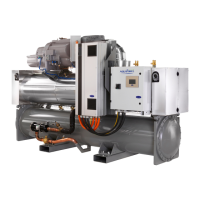
